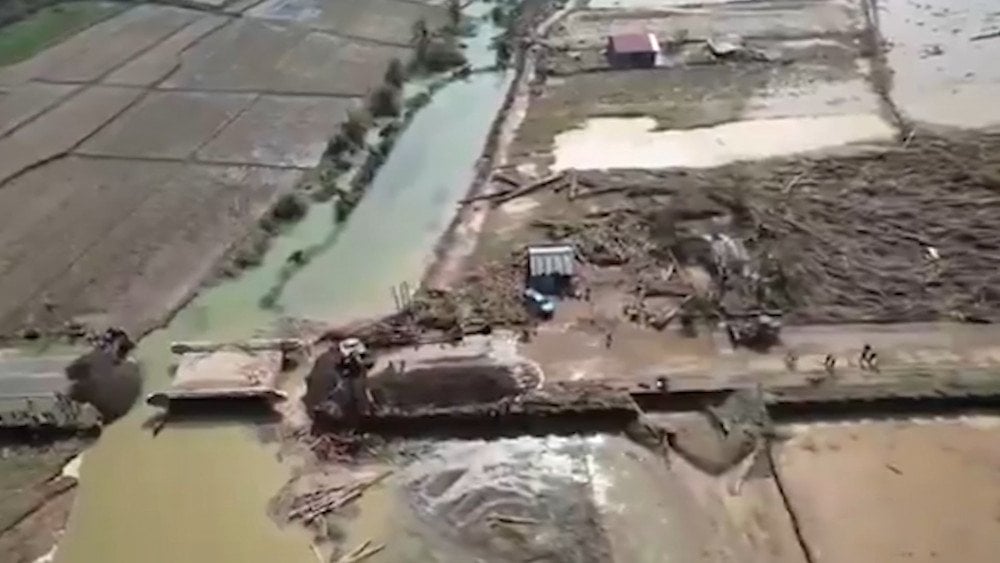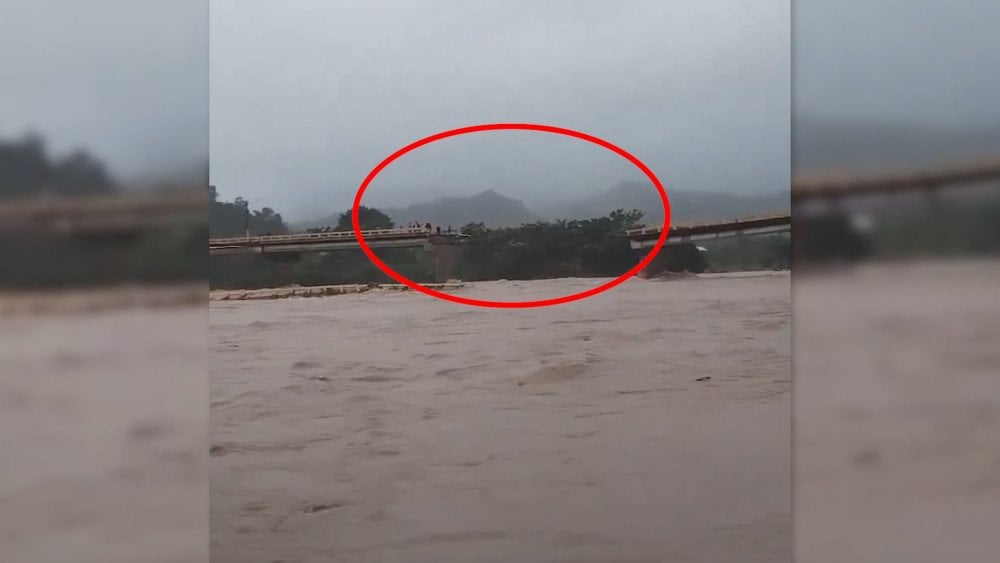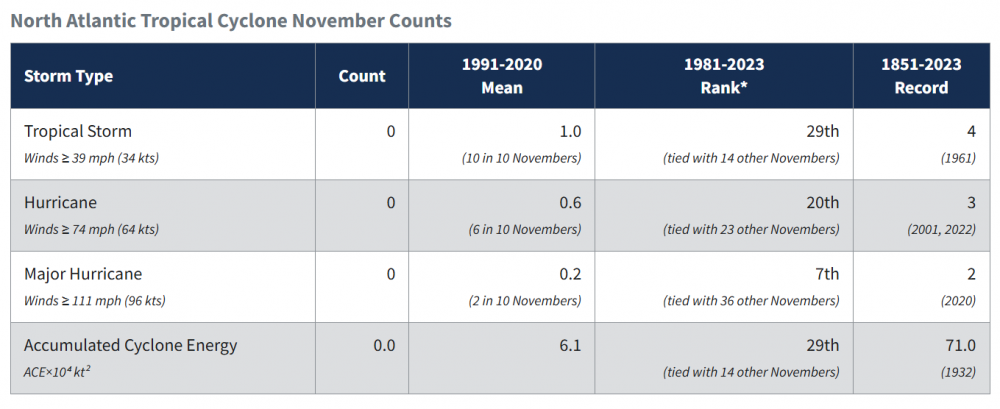Summary of Climate Disasters on the Planet: November 13-19, 2024
Italy
From November 12 to 13, heavy rains struck the Italian island of Sicily, particularly impacting the metropolitan areas of Catania and Messina.
Continuous downpours caused flooding and infrastructure damage in the city of Catania and its surroundings. Torrential streams inundated underground passages and residential buildings. Many schools in the city were closed.
On the coast of Torre Archirafi, in the province of Catania, floodwaters swept numerous vehicles into the sea. Some cars were tossed tens of meters (dozens of yards) from the beach onto rocks, while others were buried in mud and debris.

Floodwaters overturned and carried a car away from the shore, province of Catania, Italy
In the city of Licata, 53 mm (2.08 inches) of rain fell within just a few minutes, creating significant challenges for those living and working on the ground floors of buildings. Heavy rains also disrupted transportation.
In the cities of Mascali and Acireale, landslides were reported. In the commune of Giarre, 400 mm (15.75 inches) of rain fell in just six hours, nearly matching the annual average precipitation (the annual average is 429.3 mm or 16.9 inches).

Record rainfall flooded streets in the commune of Giarre, province of Catania, Italy
Over a span of 10 days, 1,000 liters of rain per square meter (39.37 inches) fell, marking a historic anomaly for the region.
The Philippines
Super Typhoon Usagi
The Philippines faced an unprecedented series of natural disasters—six typhoons struck the country in less than a month, with four hitting within just 10 days! These disasters claimed the lives of at least 171 people, affected 9 million individuals, and caused significant damage to the nation's economy.
On November 14, Super Typhoon Usagi, also known in the Philippines as “Ofel,” made landfall near the municipality of Baggao in Cagayan Province. Maximum sustained winds reached 175 km/h (109 mph), with gusts up to 240 km/h (149 mph). Villages were submerged, power lines were destroyed, and thousands of residents were left homeless.
The disaster forced the evacuation of 24,000 people. At the same time, many residents affected by the previous Typhoon Toraji, which had displaced over 80,000 people, were still taking refuge in shelters. In Cagayan Province, Luzon region, a key concrete bridge connecting two towns collapsed, while others were flooded, cutting off transportation routes. Rescuers used boats to evacuate stranded residents.

Super Typhoon Usagi destroyed a concrete bridge in Cagayan Province, Luzon region, Philippines
Super Typhoon Man-Yi
On the evening of November 16, at 9:40 PM local time, another super typhoon struck the Philippine municipality of Panganiban in Catanduanes Province.
“Man-Yi,” known locally as “Pepito,” brought maximum sustained winds of 195 km/h (121 mph) with gusts reaching 325 km/h (202 mph). The winds howled ominously, and waves as high as 7 meters (23 feet) inundated coastal areas. Over 750,000 people sought refuge in churches, shopping centers, and other temporary shelters. The province was left entirely without power, and local officials estimated that restoring the electrical grid could take months.

Super Typhoon Man-Yi forced people to abandon their homes and seek shelter, Philippines
The following day, the typhoon struck the municipality of Dipaculao in Aurora Province, where sustained winds reached 185 km/h (115 mph) with gusts up to 305 km/h (190 mph).
In the municipality of Ambaguio in Nueva Vizcaya Province, a landslide claimed the lives of seven people, injured three others, and left three more missing. Rescue operations are ongoing.
In the city of Ilagan, Isabela Province, around 500 homes were flooded, many up to their roofs.
In Camarines Norte Province, an elderly man died after his motorcycle hit a fallen power line. Nationwide, approximately 8,000 homes were destroyed or damaged, and over 100 towns and cities were left without electricity.
According to the Philippine Civil Aviation Authority and the Coast Guard, at least 26 domestic and two international airports were temporarily closed. Inter-island ferry services and cargo transport were suspended due to the severe storm at sea, leaving thousands of passengers stranded.

Transportation was halted due to severe storms and flooding caused by Super Typhoon Man-Yi, Philippines
The series of devastating natural disasters inflicted massive losses on the Philippines’ agriculture. Significant damage to rice fields may necessitate increased rice imports, as rice is the country’s staple food.
Israel
On November 19, unprecedented rainfall struck Israel. In the city of Zikhron Ya’akov, the heaviest downpour in the country’s history occurred. Within just four hours, a record-breaking 196 mm (7.72 inches) of rain fell, accounting for nearly 60% of the annual rainfall in the region. Remarkably, 159 mm (6.26 inches) of rain fell in just 2.5 hours. According to Dr. Amir Givati, director of Israel’s Meteorological Service, this amount of rainfall set a new national record.

The massive rainfall caused widespread flooding of homes, Israel
Drainage systems, although prepared for rain, were unable to handle such an abnormal volume of water, leading to large-scale flooding in many communities. Coastal Highway 2, running south of Haifa, was blocked, severely disrupting transportation in the region.
Spain
Another water nightmare struck Spain, whose residents had not yet recovered from the deadly flooding of late October.

Devastating aftermath of flooding in Spain
Thousands of people were forced to evacuate when powerful rains hit the southern and eastern regions of the country starting November 13.
The regions of Andalusia and Catalonia were especially affected, with Spain’s Meteorological Agency (AEMET) issuing a red alert.
Faced with the dire aftermath of the previous disaster, authorities took preventative measures to avoid casualties. These included closing all educational institutions, limiting hospitals’ and medical centers’ work, cutting off electricity, and halting urban transport and train services.

A powerful downpour flooded city streets, Spain
In the city of Málaga, around 100 mm (3.94 inches) of rain fell within a few hours, nearly matching the average monthly rainfall for November (100.5 mm or 3.96 inches). This caused the worst flooding in the region in 35 years.
Rail services between Málaga, Madrid, and Barcelona were disrupted, and several highways were closed.
Three waterspouts formed off the coast of Marbella, with one reaching IF1 intensity and ripping the roof off a gas station.
In Dénia, Alicante Province, wind gusts reached up to 84 km/h (52 mph), while waves along local beaches rose to 4 meters (13 feet) high.
Singapore
On November 16, flood warnings were issued for 10 locations across Singapore.
The northwestern part of the country was hit hardest, receiving 108.4 mm (4.27 inches) of rain within just two hours. This accounted for 43% of the average monthly rainfall for November and marked the highest daily rainfall recorded in 46 years.
Singapore’s National Water Agency (PUB) reported that the torrential rain caused sudden flooding near King Albert Park MRT station. The floodwaters also impacted Bukit Timah Road.
When compared to the devastating typhoons and floods in other countries, the event in Singapore might seem minor.

Sudden flooding in Singapore
It’s important to understand that Singapore ranks among the top five countries with the lowest scores on the World Risk Index, thanks to its favorable location and well-prepared infrastructure and economy.
However, the record rainfall—the highest in nearly half a century—highlights that the intensifying climate disasters are making even previously protected regions unsafe.
Tropical Storm Sarah
Tropical Storm Sarah made landfall on the night of November 14–15 along the border between Honduras and Nicaragua. The storm claimed the lives of at least four people in the two countries.
Its slow movement caused prolonged rains and widespread flooding across 15 of Honduras' 18 departments. In La Ceiba, 556 mm (21.89 inches) of rain fell in just 24 hours, compared to the average monthly rainfall for November of 155 mm (6.1 inches).

Severe flooding caused by Tropical Storm Sarah, Honduras
In the capital city of Tegucigalpa, the Choluteca River overflowed, rising by 4 meters (13.1 feet), leading to the closure of bridges and the evacuation of hundreds of residents.
The storm also severely impacted the Caribbean region of Honduras, destroying roads, bridges, and aqueducts, leaving 209 communities isolated. Nationwide, more than 7,500 homes were damaged or destroyed. Torrential rains flooded fertile lands, disrupting agricultural and industrial operations.

Tropical Storm Sarah destroyed a bridge, Honduras
Beyond Honduras and Nicaragua, Tropical Storm Sarah also affected Costa Rica, Belize, and Guatemala. Across Central America, more than 120,000 people were left homeless or affected by sudden flooding and landslides.
The Atlantic hurricane season typically begins in June and ends in November. By this time of year, hurricane activity usually subsides, with an average of no more than one tropical storm forming in November. Only once every five years does one of these storms escalate to a major hurricane of Category 3 or higher, according to NOAA’s National Centers for Environmental Information. However, this November saw two devastating events within just 20 days, according to the AccuWeather Hurricane Tracker: Tropical Storm Sarah (November 14–18). Category 3 Hurricane Rafael (November 4–11). And the hurricane season is not over yet.

Average number of tropical storms in the North Atlantic, based on NOAA’s National Centers for Environmental Information
It is now widely understood that the abnormal rainfall, unprecedented storm intensity, and atypical behavior of tropical hurricanes are caused by the overheated global ocean. In 2023, sea surface temperatures broke all records, and 2024 is already surpassing those levels. Moreover, over the past 30 years, the rate of ocean warming has accelerated by 450%, raising serious concerns about why this is happening.
Studies show that over the past 60 years, the deep ocean has been warming 15 times faster than during the previous 10,000 years. This level of warming requires an enormous amount of energy. But where does this energy come from at such depths, where solar energy does not penetrate?
Scientists suggest that the heat sources could be undersea volcanoes, tectonic faults, and hydrothermal vents, as there are more than 10 million of them in the ocean.
Another problem is plastic pollution in the ocean. The size of floating plastic islands now rivals the combined areas of the United States and Australia. As plastic degrades, it disrupts the thermal conductivity of water, reducing the ocean’s ability to cool the planet effectively.
Some scientists believe that if the situation with the ocean does not improve, climate disasters could wipe out all life on Earth. The planet needs a well-functioning cooling system. The documentary film “Climate Crisis and Ocean Pollution: Global Challenges and Solutions,” presented by the volunteers of the ALLATRA Movement at the COP16 conference, explores this issue in detail and proposes a practical solution. This solution not only aims to reduce the frequency and intensity of climate disasters worldwide but also to provide clean drinking water for everyone without limitation.
Watch the video version of this article here:
Leave a comment